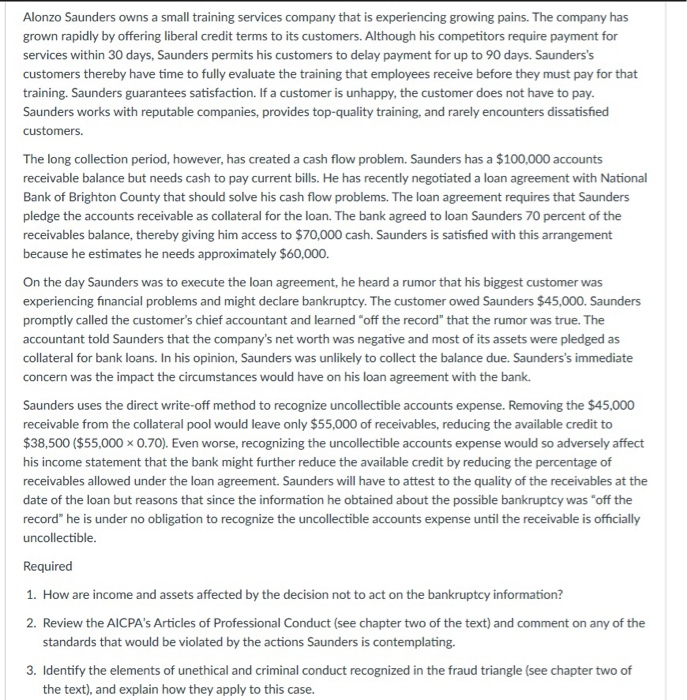Alonzo Saunders owns a small training services company that is experiencing growing pains. The company has grown rapidly by offering liberal credit terms to its customers. Although his competitors require payment for services within 30 days, Saunders permits his customers to delay payment for up to 90 days. Saunders's customers thereby have time to fully evaluate the training that employees receive before they must pay for that training. Saunders guarantees satisfaction. If a customer is unhappy, the customer does not have to pay Saunders works with reputable companies, provides top-quality training, and rarely encounters dissatisfied customers. The long collection period, however, has created a cash flow problem. Saunders has a $100,000 accounts receivable balance but needs cash to pay current bills. He has recently negotiated a loan agreement with National Bank of Brighton County that should solve his cash flow problems. The loan agreement requires that Saunders pledge the accounts receivable as collateral for the loan. The bank agreed to loan Saunders 70 percent of the receivables balance, thereby giving him access to $70,000 cash. Saunders is satisfied with this arrangement because he estimates he needs approximately $60,000. On the day Saunders was to execute the loan agreement, he heard a rumor that his biggest customer was experiencing financial problems and might declare bankruptcy. The customer owed Saunders $45,000. Saunders promptly called the customer's chief accountant and learned "off the record" that the rumor was true. The accountant told Saunders that the company's net worth was negative and most of its assets were pledged as collateral for bank loans. In his opinion, Saunders was unlikely to collect the balance due. Saunders's immediate concern was the impact the circumstances would have on his loan agreement with the bank. Saunders uses the direct write-off method to recognize uncollectible accounts expense. Removing the $45,000 receivable from the collateral pool would leave only $55,000 of receivables, reducing the available credit to $38,500 ($55,000 x 0.70). Even worse, recognizing the uncollectible accounts expense would so adversely affect his income statement that the bank might further reduce the available credit by reducing the percentage of receivables allowed under the loan agreement. Saunders will have to attest to the quality of the receivables at the date of the loan but reasons that since the information he obtained about the possible bankruptcy was "off the record" he is under no obligation to recognize the uncollectible accounts expense until the receivable is officially uncollectible. Required 1. How are income and assets affected by the decision not to act on the bankruptcy information? 2. Review the AICPA's Articles of Professional Conduct (see chapter two of the text) and comment on any of the standards that would be violated by the actions Saunders is contemplating. 3. Identify the elements of unethical and criminal conduct recognized in the fraud triangle (see chapter two of the text), and explain how they apply to this case







